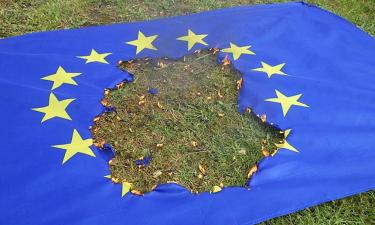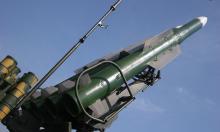The Amber Room: the hoax continues
On June 5, on the eve of the 60th anniversary of D-Day, a book, "The Amber Room: The Untold Story of the Greatest Hoax of the Twentieth Century" by Adrian Levy and Cathy Scott-Clark, appeared in British bookshops. The authors claim that the Amber Room, a masterpiece created by 18th century German craftsmen, burned down in a fire at Konigsberg Castle due to the negligence or vandalism of Soviet troops after the Red Army seized Konigsberg.
The authors refer to documents they recently uncovered in Russian archives. An entry about the castle fire was made in his working notes by Anatoly Kuchumov, a former staff member of the Tsarskoye Selo museum and the Amber Room's curator.
It should be recalled that the Amber Room was the most luxurious of the premises of the St Catherine Palace in Tsarskoye Selo outside St Petersburg. Prussian King Frederick I gave it to Peter the Great as a present in 1717. The room was, in fact, a huge casket panelled in amber.
When the Nazis attacked the USSR, museum staff did not have any time to dismantle the treasure and just pasted wallpaper over it. However, the Nazis discovered the ruse, stripped off the paper and sent the room to Konigsberg and the castle, which housed a museum. There, the treasure was re-assembled and put on a display as a trophy.
The final fate of the masterpiece remains unknown.
According to one of the most authoritative hypotheses, it was taken to Germany, where among many other masterpieces that SS detachments hid in mines and other places, it finally disappeared.
However in their book, Adrian Levy and Cathy Scott-Clark set forth a version that immediately became a world sensation.
The point at issue is that while investigating the fate of the lost masterpiece in Konigsberg in the first days after Soviet troops entered the area, Kuchumov made friends with a former bartender from the officers' bar at Konigsberg Castle. The bartender told him that Soviet troops had set the castle on fire, thereby destroying everything in the Knights' Hall where the cases with the packed Amber Room had been stored.
However, on the day of the fire, April 12, 1945, the bartender was in hospital and only learnt about the incident from his acquaintances when he returned to the bar.
The authors of the sensation found Kuchumov's notes in the Central State Archive of Literature and Arts in St Petersburg. However, after they found the documents they cite, Levy and Scott-Clark did not deem it necessary to discuss them with Russian experts, preferring instead to describe their finding in a huge pre-publication PR campaign. This position prompts one to think that the authors were driven by commercial motives rather than truly academic interests and a desire to establish the truth. The authors' position makes one cautious and suggests that a critical approach attitude to the facts they cite should be adopted.
However, apart from the moral aspect of the matter, their sensation is far from flawless. For example, they cannot explain how the most important part of the Amber Room survived, if the whole treasure burned down in the castle due to soldiers' negligence.
The point is that a fragment of the room that was recently found in Bremen, in the flat of a certain Hans Achtermann. He offered it to antique specialists for $2.5 million, after which he was arrested.
The discovery became an object of a special concern for the German government and by the 300th anniversary of St Petersburg, the fragment had been solemnly returned by the Bremen burgomaster to Russia and installed in its former place.
By that time, though, St Petersburg restorers had recreated the entire room. The masterpiece had been revived.
While explaining how the fragment found its way into his house, Achtermann said that his father, a former Wehrmacht officer, had brought it from Russia. He allegedly saved the panel during a bombing raid in 1941, when the masterpiece was being evacuated from the St Catherine Palace to Konigsberg.
If it were a small fragment, a piece of amber, this act of looting would not be at variance with the destruction of the room in a fire.
However, the fragment is the heart of the composition, the central unique panel "Smell and Touch", created by Italians using the Florentine mosaic technique (there were four such panels). This panel adorned the centre of an amber wall the way a diamond adorns the ring. The colour of the Florentine mosaic made of the most precious stones was a decorative "tuning-fork" to select the shades for the rest of the amber.
However, if the Florentine mosaic had been stolen in 1941, the later demonstration of the assembled Amber Room in the Konigsberg castle would have been impossible. A black hole in the centre of the exquisite amber composition would have deprived the masterpiece of half of its fascination and half its value. However, it is a fact that the Amber Room was permanently exhibited in the museum under the patronage of art expert Doctor Rose. And there are no indications that in the halls of Konigsberg Castle the Amber Room was on display with this flaw. Its beautiful core might have been stolen later, in the Nazis' last days.
This question alone is quite enough to make one doubt the version of the authors of the book that the whole Amber Room burned down in a fire.
The same question makes one also doubt Achtermann's story about the feat of his father who "saved the mosaic" during a barbarous Russian bombing raid. But why did he save the mosaic and not return it? The year 1941 was not the right time for Germans to loot treasures that were under the patronage of the Reich.
It would be more logical to suggest that everything did not fit so well and that he stole it at the height of the panic-stricken flight from Konigsberg, in the fatal year of 1945, not in 1941. Judging by everything, this happened during the evacuation of the masterpiece to Germany when - a month before the surrender and fall of the Third Reich - the theft of a Florentine mosaic no longer promised any serious consequences for a Wehrmacht officer.
Subscribe to Pravda.Ru Telegram channel, Facebook, RSS!





